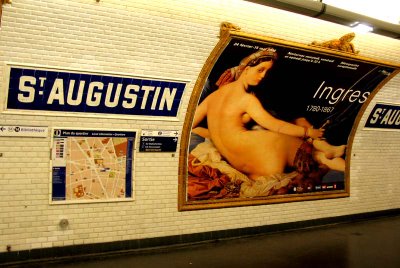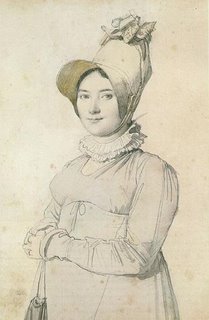Ingres at the Louvre (Part 1 of 2)
 When I found out I was coming to France this month, I realized with some excitement that I would be here in Paris during the Ingres retrospective at the Louvre. It's a blockbuster show – 180 paintings and drawings in the Hall Napoléon, on the museum's lower level – that was as crowded as hell on Sunday afternoon. Fortunately, a new device in use at the museum kept things nominally under control – a counter that keeps track of the total number of visitors in the exhibit at all times. As people left, we in the line were allowed to enter. It made the wait outside longer, or so it seemed, but once inside one had somewhat less trouble with the elbows of other museum-goers in one's ribs.
When I found out I was coming to France this month, I realized with some excitement that I would be here in Paris during the Ingres retrospective at the Louvre. It's a blockbuster show – 180 paintings and drawings in the Hall Napoléon, on the museum's lower level – that was as crowded as hell on Sunday afternoon. Fortunately, a new device in use at the museum kept things nominally under control – a counter that keeps track of the total number of visitors in the exhibit at all times. As people left, we in the line were allowed to enter. It made the wait outside longer, or so it seemed, but once inside one had somewhat less trouble with the elbows of other museum-goers in one's ribs.
The show is, I can now say first-hand, a success: well researched, intellectually stimulating, well presented, as near to exhaustive as possible without being exhausting, and beautiful to behold. The text, presented in French with English and Spanish translations in parallel, is concise and informative. It does not overwhelm with biographical detail but gives, in its chronological layout, a convincing account of a fascinating life. In particular, this show finally gave me an understanding of how the career of Ingres intersected with the reign of Napoléon I, as well as the monarchies restored in France after the empire. Above all, I enjoyed getting to learn about paintings other than those that are most known to anglophone art aficionados – because reproductions of them are shown in the major surveys, like that of Janson, recently given a somewhat controversial revision – La Grande Odalisque (shown above in the Paris Métro) and her sisters. Those paintings (and drawings) are here, to be sure, but the exhibit puts them into the context of a long and productive career. Jean-Auguste-Dominique Ingres (1780-1867) had an Internet wife – well, at least that would be, I suppose, the modern equivalent: they met and courted only through letters. She went to meet him in Rome – where he lived for some 25 years, first as a student who had won the coveted Prix de Rome and then as the director of the Villa Médicis – and they were married shortly afterward. It was by all accounts a happy marriage, one marked by passionate love for over 30 years. In a charming story, the older couple was surprised in the conjugal act (to borrow the polite French phrase) in their carriage just outside the Paris Opéra. Opera can indeed stoke the flames. The only tragic note in this relationship was the loss of their first and only child, who was stillborn. The most moving piece in the show for me was one of the ten known portraits, all ink drawings, that Ingres made of his wife, Madeleine. The curators have brought together nine of them; the present location of the tenth, they explain in their catalogue, is unknown. The best one shows Madeleine radiant in pregnancy (shown at right). In the other portraits (here with her husband and here in three-quarters view), she appears just as happy, but children were not part of their life together.
Jean-Auguste-Dominique Ingres (1780-1867) had an Internet wife – well, at least that would be, I suppose, the modern equivalent: they met and courted only through letters. She went to meet him in Rome – where he lived for some 25 years, first as a student who had won the coveted Prix de Rome and then as the director of the Villa Médicis – and they were married shortly afterward. It was by all accounts a happy marriage, one marked by passionate love for over 30 years. In a charming story, the older couple was surprised in the conjugal act (to borrow the polite French phrase) in their carriage just outside the Paris Opéra. Opera can indeed stoke the flames. The only tragic note in this relationship was the loss of their first and only child, who was stillborn. The most moving piece in the show for me was one of the ten known portraits, all ink drawings, that Ingres made of his wife, Madeleine. The curators have brought together nine of them; the present location of the tenth, they explain in their catalogue, is unknown. The best one shows Madeleine radiant in pregnancy (shown at right). In the other portraits (here with her husband and here in three-quarters view), she appears just as happy, but children were not part of their life together.
This point is then connected with another series of beautiful drawings – many of these works are on loan from the Musée Ingres in Montauban, where Ingres was born – of young children, sometimes with their parents. These drawings, which are all sweet portraits, are heart-breaking because they probably represent Ingres's longing to have children: a young boy, perhaps 5 years old, sprawled out in a chair too large for him; two happy parents with young children; a toddler – Marie Marcotte, perhaps 2 – in a high chair (now in private hands); a giggling child, Charlotte-Madeleine Taurel, with a lamb, the vision of innocence. (On a related note, in one of his small-format, lighter paintings, Henri IV and Marie de Médicis receive the Spanish ambassador: the queen, an often cold and formal person, is seated rigidly on a throne, while the king rolls in horseplay with three of his children on the floor.) Ingres, the one-time apprentice of Jacques-Louis David, was a masterful draftsman, and every drawing in the exhibit reveals an aspect of his mastery, often stages in his realization of major paintings, as he shifted the position and expression of his model. Many are related to paintings also on exhibit.
Michael Kimmelman, Ingres at the Louvre: His Pursuit of a Higher Reality (New York Times, March 24) Jorg von Uthmann, Louvre Celebrates Painter Ingres's Bourgeois Matrons, Nymphs (Bloomberg News, March 1) Richard Dorment, Truth in a parallel universe (The Telegraph, February 28) Philippe Dagen, Ingres, l'ange du bizarre (Le Monde, February 24) Vincent Noce, Dédale d'Ingres (Libération, February 24) Angela Doland, Louvre exhibits many dimensions of Ingres (Associated Press, February 24) Charles T. Downey, Ingres Drawings in Montauban (Ionarts, January 19) |
Go to Part 2.





















































No comments:
Post a Comment